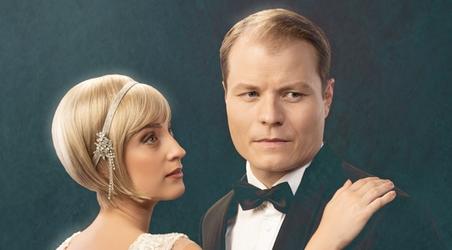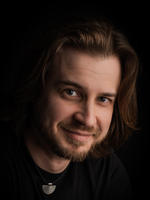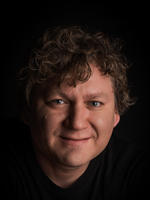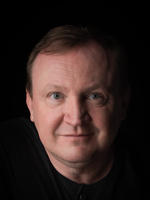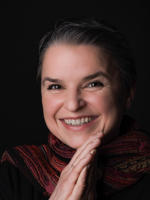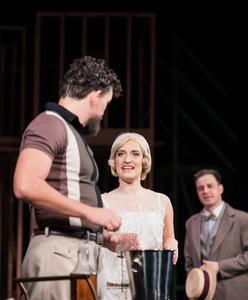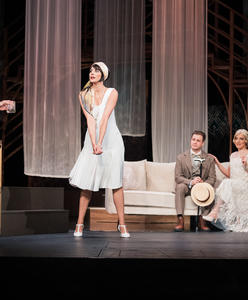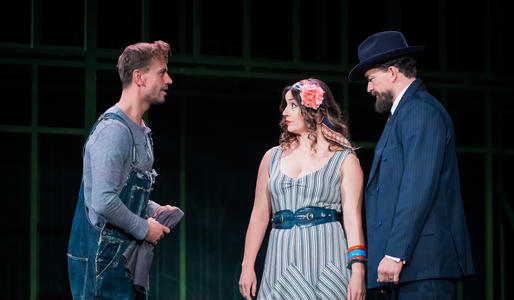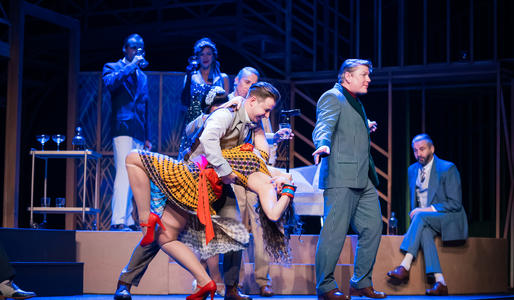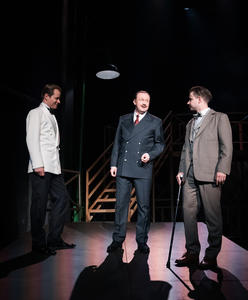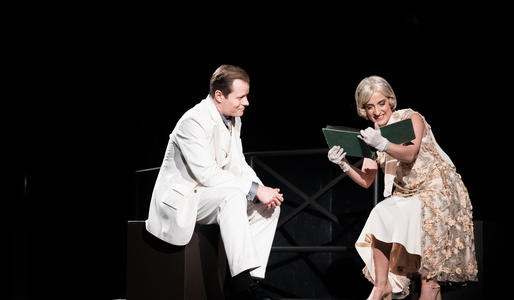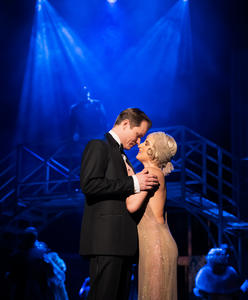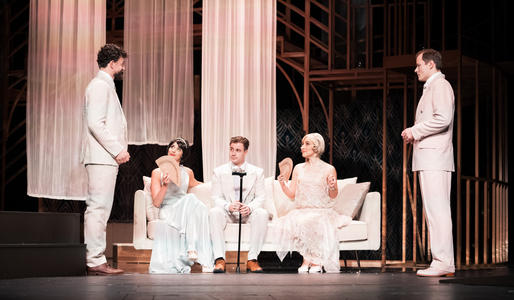Gatsby on Stage Respects the Novel. But What about the Audience?
Jana Soukupová 10. November 2023 zdroj MF Dnes
The Great Gatsby, evidently the most famous novel by the American writer Francis Scott Fitzgerald, has seen numerous film and theatre adaptations since it was written in 1925. Brno City Theatre has reached for the adaptation by the American playwright Simon Levy from 2006 and, as directed by Petr Gazdík, given it a place in its dramatic repertoire.
This is a commendable act, although at Brno City Theatre it is a bit like banging your head against the wall. The message of the novel about the ambiguous character of the ambitious alcohol dealer Gatsby at the time of Prohibition America, whose genuine feelings for the pampered Daisy, if little else, make him morally superior to his “virtuous” surroundings, is so subtle in meaning and encoded in the equivocal personalities of the characters that one might fear that the local audience will be less interested. Nonetheless, the author of the dramatisation, the director and the actor in the title role (Lukáš Janota) have done their very best to convey this otherwise highly literary material. And along with the more or less appropriate casting of the other roles, they have not taken anything essential from the novel’s message, unless of course we count the poetic manner of Fitzgerald’s prose style which simply cannot be transferred to the stage, as can be seen in even the most successful film adaptation.
In the novel and its dramatisation, the “narrator” Nick Carraway is the distant and as yet far from affluent cousin of the beautiful Daisy, who is married to the rich Tom Buchanan. Nick is the only one of the characters who can, and also wants to, unravel Gatsby’s moral ambiguity, while his own story of his relationship with the golfer Jordan Baker, who is above all a reckless companion of the idle rich, appears peripheral.
At Brno City Theatre, the casting of Jan Brožek and Diana Velčická, whose acting is rather muted and less expressive than that of the other characters, corresponds to this. The masterful performance by the well-cast Lukáš Janota somewhat trumps the performances of all the others with its precision and certainty. Kristýna Daňhelová is certainly not a bad Daisy, though we tend to believe her charm rather than the position of a fragile beauty that is so necessary to this character, while Dušan Vitázek is more of an absent-minded snob than truly evil in the role of her condescending husband.
But what would a smaller and more intimate theatre, where a piece of this kind would receive a decidedly warmer reception, give for such a production and performances?
The Great Gatsby Appeared in Romantic Attire at Brno City Theatre
Michal Švanda 8. November 2023 zdroj www.kulturio.cz
(…) Brno City Theatre has chosen an adaptation by the experienced American director, playwright and screenwriter Simon Levy as the text for its stage production of this famous work. The Great Gatsby is one of his three adaptations of Fitzgerald’s novels. It could be said that the creators of the production in Brno have turned to the most highly qualified expert. The strength of Levy’s rendering is that it fully respects the famous original. It relies on the power of the original text and endeavours to convey it to us as much as possible. (…) The stage makes use of multiple levels and provides the opportunity for movement, which is important, for example, during the dance scenes that give the production the necessary “jazz” dimension. At the same time, however, it is also true that the concept of the staging is rather modest and does not evoke the feeling of the luxurious residences of the social elite in which most of the action takes place. The costumes and overall stylisation of the characters strive for period authenticity, and this can also be said to be true of the overall concept behind the production. Appreciation must be given for the fact that the play makes no attempt to transform the original text into different positions and that it conveys to us one of the important works of modern literature.
America of the Twenties with The Great Gatsby on the Drama Stage at Brno City Theatre
(tr) 6. November 2023 zdroj www.brnozurnal.cz
(…) The performance of The Great Gatsby on the Drama Stage is entrancing even before the actors speak. Eliška Lupačová Ondráčková has created wonderful costumes in the style of the aforementioned America of that time. We are in high society, so ladies certainly do not have just a single dress. This also suits Kristýna Daňhelová in the role of Daisy Buchanan. Although she is Gatsby’s lover, she is the wife of someone else – Tom Buchanan, who she married (he is rich and her social equal) when Gatsby did not come back from the war. A seemingly banal story develops from this simple plot device, namely their meeting five years later which culminates in an unexpected and tragic twist that reveals the characters. (…) The title role is played by Lukáš Janota. He is a self-confident but unpretentious rich man. He likes to dress nicely and drive a car, but he wants Daisy to come back to him. Both performers (Janota and Daňhelová) are more familiar to the audience of the City Theatre from the Music Stage (...). Musically educated Lukáš Janota also wrote pleasant music for the production, during which we also hear phrases from George Gershwin. The role of husband Tom Buchanan suits Dušan Vitázko well. He is a determined tough guy, the counterpart of the softer Gatsby, so many viewers, and female viewers in particular, may not regret the outcome of the plot. Zuzana Holbeinová and Ondřej Studénka make for a likeable, if incongruous, pair as husband-and-wife Myrtle and George Wilson. He in particular, a car mechanic, represents a lower-class character. Milan Němec as a devious extortionist and Jakub Uličník can also not be overlooked in other roles. Other members of society are the ladies Johana Gazdíková and Eva Jedličková and aristocratic Patrik Borecký. Ivana Vaňková, who sings at a party, stands out among the six characters representing New York society. Director and translator Petr Gazdík worked with the actors on a set built by Petr Hloušek. Demanding for the director, a spectacle for the viewer. The characters move around a lot on a metal structure representing a large house, all on a revolving stage. Choreographer Michal Matěj has also made his mark here. The opulence of the house is represented by a wide sofa with cushions. The costumes really go a long way to elevating this production. They fit everyone wonderfully, they capture the given period, and there really are a great many of them.

